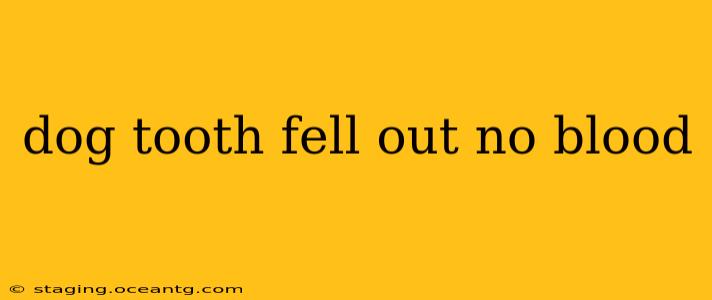Losing a puppy tooth is a normal part of development. Adult teeth replace baby teeth, much like in humans. However, if your adult dog loses a tooth unexpectedly, it's understandable to be concerned. This guide will address common concerns surrounding a dog losing a tooth without bleeding, exploring potential causes and when veterinary attention is crucial.
Why Did My Dog's Tooth Fall Out Without Bleeding?
The most common reason for a tooth falling out without bleeding in an adult dog is natural wear and tear. Over time, teeth can become loose due to gum recession, periodontal disease (gum disease), or simply the constant chewing and gnawing dogs engage in. If the tooth is already significantly weakened, its loss might not cause any bleeding.
In younger dogs, the loss of a tooth without bleeding likely signifies the shedding of a baby tooth to make way for its adult counterpart. This is a perfectly natural process and nothing to worry about.
What if My Dog's Tooth Fell Out and There's No Blood? Should I Be Worried?
While often benign, a tooth falling out without bleeding warrants observation. Monitor your dog for:
- Changes in eating habits: Is your dog struggling to eat? Are they favoring one side of their mouth?
- Excessive drooling: This could indicate pain or discomfort.
- Pawing at the mouth: This might suggest irritation or pain in the area where the tooth was lost.
- Swelling or inflammation: Examine the gums carefully for any signs of infection.
- Unusual behavior: Is your dog lethargic, less playful, or exhibiting any other unusual behavior?
My Dog Lost a Tooth: Is it Periodontal Disease?
Periodontal disease is a significant concern in dogs. It's a progressive infection of the gums and supporting structures of the teeth, leading to tooth loss. While a single tooth falling out might not immediately indicate periodontal disease, it's a potential sign, especially if accompanied by other symptoms like bad breath, red or swollen gums, or loose teeth.
How Can I Tell if My Dog Has Periodontal Disease?
Regularly check your dog's teeth and gums. Look for:
- Bad breath (halitosis): A strong, unpleasant odor from your dog's mouth is a common sign.
- Red, inflamed, or swollen gums: Healthy gums are pink and firm.
- Loose teeth: Gently check your dog's teeth for looseness.
- Plaque and tartar buildup: This yellow-brown substance on the teeth is a breeding ground for bacteria.
When Should I Take My Dog to the Vet?
You should contact your veterinarian if:
- Your dog shows any of the symptoms listed above.
- The tooth loss is accompanied by bleeding or significant pain.
- Multiple teeth are falling out.
- Your dog is displaying any signs of distress.
- You're unsure about the cause of the tooth loss.
A veterinarian can properly diagnose the underlying cause and recommend the appropriate treatment, whether it's simple observation, professional dental cleaning, or more involved procedures.
How Can I Prevent Tooth Loss in My Dog?
Proactive dental care is crucial for maintaining your dog's oral health. This includes:
- Regular brushing: Brush your dog's teeth at least two to three times a week using a dog-specific toothpaste.
- Dental chews: Provide your dog with dental chews designed to help scrape away plaque and tartar.
- Dental diets: Some dog foods are formulated to help support dental health.
- Regular veterinary checkups: Schedule annual checkups for your dog, which should include an oral examination.
Remember, prevention is key! By taking proactive steps to maintain your dog's dental hygiene, you can significantly reduce the risk of tooth loss and other oral health problems. Early detection and intervention are crucial for managing any dental issues.
